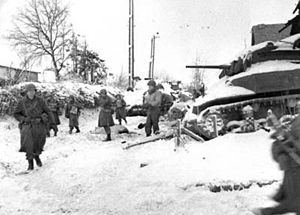Battle of the Bulge

The Battle of the Bulge was one of World War II‘s most important military confrontations and perhaps one of the most influential events of the twentieth century. It occurred near the end of the war, from mid-December 1944 until the end of January 1945 and was at its core a German assault on parts of central Europe, most notably Belgium, France and Luxembourg. The most intense fighting took place in the forests of Ardennes, a weaker part of the front defended by exhausted and worn out Allied forces.
Germany’s Last Desperate Measure
The attack began on the morning of the 16th of December. German forces used over 1,500 artillery guns to bombard an especially densely forested section of the western front; the end goal was to break through this front, which had essentially become a stalemated area due to heavy fortifications and defensive setups on both sides. The Germans believed that if the offensive was successful, victory in the European theater would be theirs.
For this reason, American general Dwight D. Eisenhower was determined to stem the invasion at all costs. Though the Americans who felt the brunt of the initial attack believed that it was only a minor counter-strike by the Germans, Eisenhower immediately recognized the gravity of the situation and took necessary mobilization measures. One of his best decisions was to reinforce Elsenborn Ridge, which would prove to a be key strategic point of interest for the larger battle. The ridge came under siege from the best equipped unit of the German army. The American 99th Infantry division played a decisive role in the conflict, as they were grossly outnumbered but still able to defend Elsenborn Ridge while inflicting massive casualties.
The next important collision occurred at the town of St. Vith, a Belgian town that was a crucial point for the German offensive because it was also a major crossroads. Capture of St. Vith would allow the Germans much greater mobility for tanks and heavy artillery throughout the entire region. The 106th U.S. Infantry Division was able to fend off German attacks for some time, but ended up surrendering the town and retreating to defensive positions in the area. Nevertheless, they had delayed the Germans significantly and won more time to prepare, strategize and reinforce in other areas.
The German ground attack was eventually brought to a halt, at which time General Eisenhower ordered his leading commanders to execute a counter-offensive. General George S. Patton and English Field Marshall Bernard Montgomery each led Allied armies that were separated by some 25 miles at the start of this counter-offensive. They designed to combine forces at Houffalize and trap the German army. While they were not able to move quickly enough to capture the Germans, the Allies forced them to abandon all heavy machinery in order to escape. Adolf Hitler conceded to end all offensive maneuvers on January 7th, 1944. By the 25th, all armed conflict had ceased and the Allies emerged as complete victors.
Over the course of the Battle of the Bulge, American forces suffered somewhere between 80,000 and 110,000 casualties while Germans sustained in the neighborhood of 70,000 to 90,000. It was by far the bloodiest battle of World War II for the Americans, but it also effectively sealed an Allied victory in Europe. With such a weakened and ill-equipped fighting force, the remainder of Germany’s fighting was little more than an array of last-ditch desperate measures. Hitler committed suicide on April 30 and the Germans admitted final defeat on May 7, 1945 in Italy, though World War II would still rage in the Pacific theater for several months.
